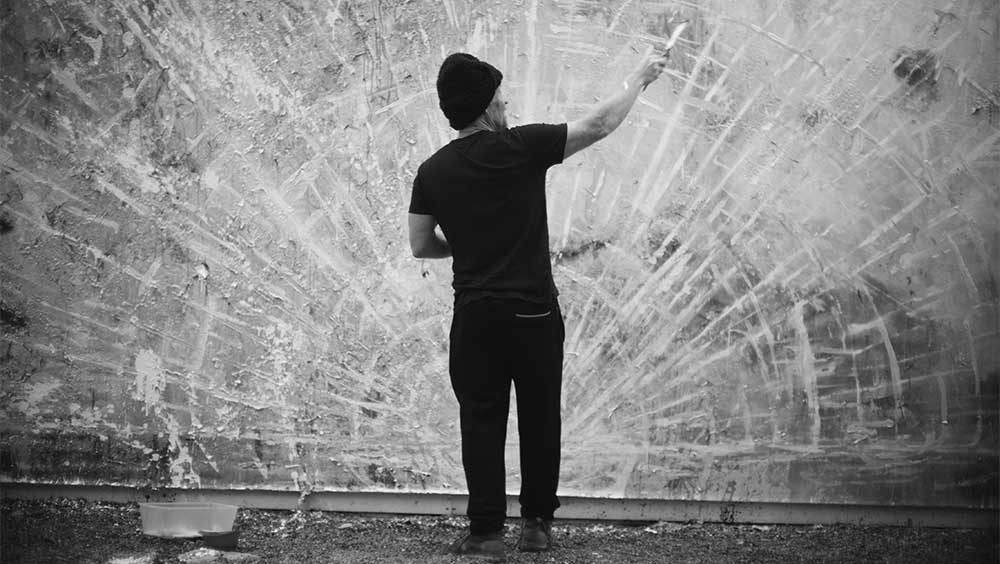
Thomas Houseago, film still, Malibu, California, 2024, courtesy of Angel Projects and Andrew Dominik.
Lévy Gorvy Dayan, New York
9 September – 19 October 2024
by LILLY WEI
The Leeds-born, Los Angeles-based sculptor Thomas Houseago is back – with a vengeance. Night Sea Journey (a Jungian term for a passage into the depths of the psyche) is the artist’s first solo show in New York in 10 years and the first since his breakdown in 2019. Houseago and his sculptures seem to feed off each other, so much so that you swear you can feel the energy ricocheting between him and the hulking, portentous figures he is known for. His recent press preview in New York introducing this show was an astonishing event, his performance – there is no other word for it, reminding us that he began his career as a performance artist – a propulsive, hypnotic monologue (peppered with expletives) of wide-ranging references and objectivity wrapped around a wrenchingly poignant personal story. A raconteur of rare charisma, he included a heavy dose of psychology and shout-outs to centuries of art history, from the sculptures of the Egyptians, the Greeks and Romans to the Renaissance and baroque to modernism, the contemporary, pop culture, and much more, including music, the influence he claims is the most essential to his practice.
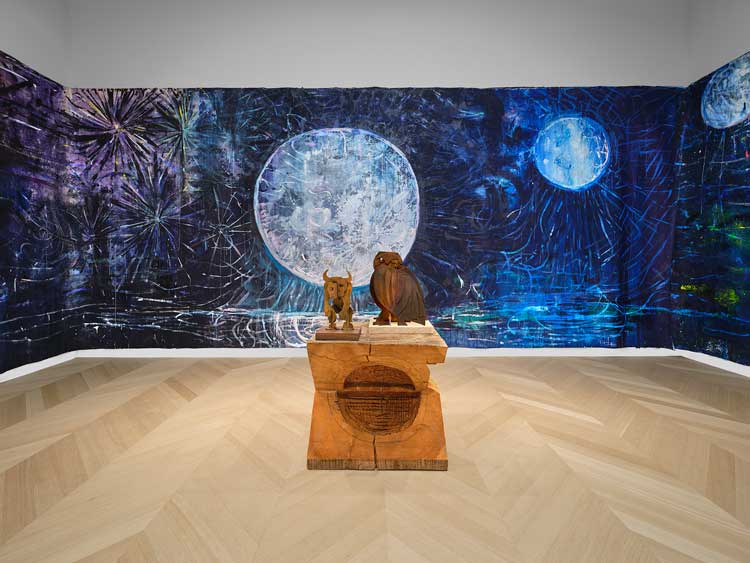
Installation view, Thomas Houseago: Night Sea Journey. Image courtesy of Lévy Gorvy Dayan gallery.
Houseago’s dial seems permanently set to the manic, but he is also kissed by the sacred, tuned to frequencies most of us are not aware of or refuse to acknowledge. (He is also a dead-ringer for Van Gogh and when the beloved Dutch painter’s biopic is – inevitably – filmed yet again, who better for the lead role?) He has already played himself, however, in an excellent documentary directed by Andrew Dominik, which is screening at the gallery for the run of the show, and highlights other aspects of his practice, including a scale that swings between hundreds of feet to the hand-held. But it is not nearly as unflinchingly raw and compelling as Houseago live.

Thomas Houseago. Giant Minotaur (for DS), 2024. Patinated bronze, 122⅛ × 29⁷⁄₁₆ × 29⁹⁄₁₆ in (310.2 × 74.8 × 75.1 cm). Installation view, Thomas Houseago: Night Sea Journey. Image courtesy of Lévy Gorvy Dayan gallery.
Entering the gallery, you encounter a fierce, majestically horned 3-metre-tall (10ft) creature, Giant Minotaur (for DS) (2024), in blackened bronze that you might want to steer clear of. He looks wildly out of place in the august beaux-arts foyer of the gallery, looming over us like an escapee from the labyrinths of the mind and the soul. Houseago tempers the menace the figure inspires, however, by averting the monster’s gaze, his shadowed eyes opaque, unreadable. He hunches the statue’s shoulders slightly, the knees bent, the stance almost submissive, genitalia exposed, limp (decidedly not in priapic mode), making him appear curiously vulnerable. His skin, or pelt, is crisscrossed, scarred and splintered by countless agitated marks, evidence of the artist’s hands-on process, wielding a chainsaw like a brush (or in his paintings, a brush like a chainsaw.) You want to touch it to make sure that it isn’t painted redwood, one of his primary materials, as are bronze, steel, and plaster. Or, perhaps, you simply want to smooth and soothe the beast’s flayed flesh, giving this sport of nature a sympathetic pat. The minotaur, the legendary offspring of an unholy passion that a mythic Minoan queen conceived for a sacred bull, is emblematic of the instinctual, the bestial, the hideous at war with the rational and what we designate as the human, the civilised, the beautiful, all of which, however, exist within us and are intertwined, the tension between our internal demons and angels, our emotional and physical trauma, it has been argued, the impetus for our creativity.
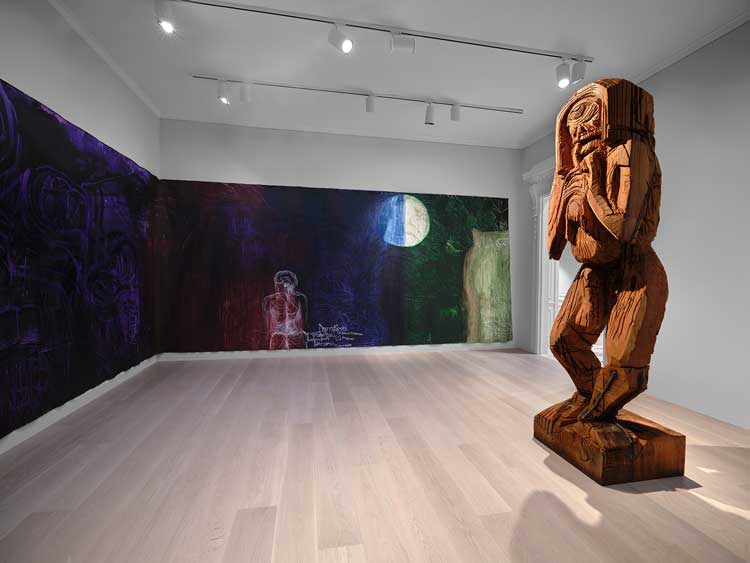
Thomas Houseago. Madness Devouring Our Children, 2024. Redwood and pastel, 123 × 30¼ × 29½ in (312.4 × 76.8 × 74.9 cm). Installation view, Thomas Houseago: Night Sea Journey. Image courtesy of Lévy Gorvy Dayan gallery.
The installation is conceived as a visual and metaphoric journey from darkness to light, a kind of untergehen in order to übergehen, as Nietzsche might put it. The first floor represents the lower depths, the subterranean realm of the chthonic deities, and the childhood trauma with which Houseago has grappled throughout his life. Fraught family relationships, abuse and the struggle between soma, psyche and suppressed memories, are some of the themes of this powerful show, shifting between the clinical and the intimate, menacingly exemplified in Madness Devouring Our Children (2024), a three-dimensional Goyaesque Chronos, the Titan who devoured his own children. And the owl again makes an appearance, with its many associations: a harbinger of death, the familiar of witches and magicians, and the constant companion of Athena, the Hellenic goddess of wisdom and war. Night Sea Journey, to a great degree, is an elegy for the dead, and the release that death may offer – of Houseago’s father to him – even if complicated, conflicted.
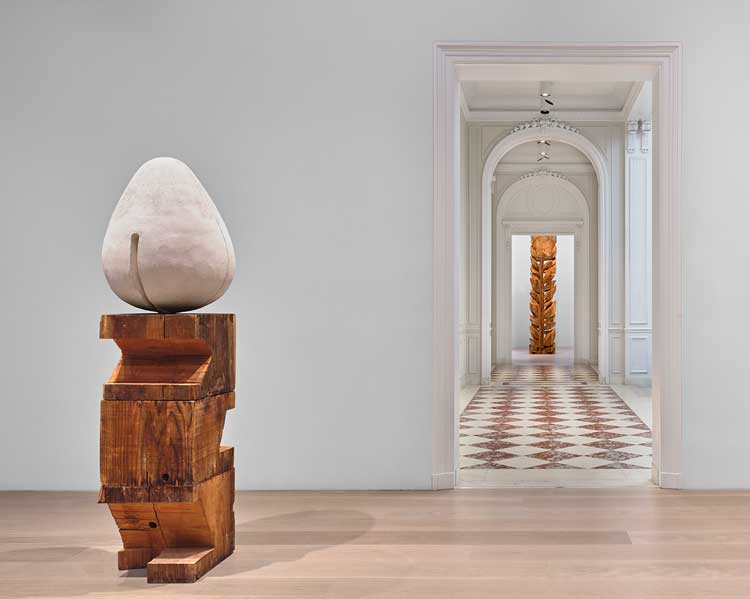
Thomas Houseago. Left: Birth II, 2023. Plaster, redwood, hemp, rebar, and pastel, 80⅜ × 22⅞ × 20½ in (204.2 × 58.1 × 52.1 cm); Right: Flower & Death, 2018/24, Redwood and pastel, 144⅞ × 29⁷⁄₁₆ × 29½ in (368 × 74.8 × 74.9 cm). Installation view, Thomas Houseago: Night Sea Journey. Image courtesy of Lévy Gorvy Dayan gallery.
The second floor is less ominous, more open-ended, varying, since it deals with what constitutes daily life. One gallery is hung with a tapestry of a sprawling, tactile nightscape, with moons, stars and constellations streaking vertiginously across it, his version of The Starry Night, perhaps. (Elsewhere, there is a gorgeous 3.65-metre high (12ft) wooden column of a finely incised sunflower that is another tribute to Van Gogh and his signature bloom.)
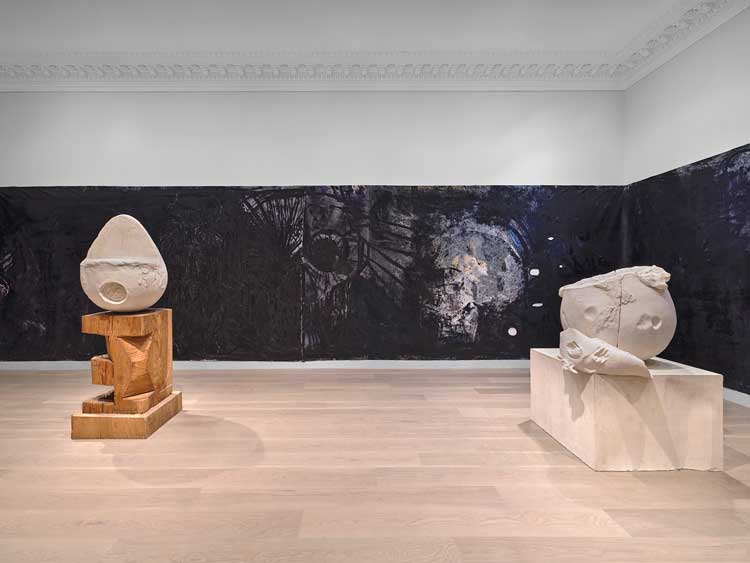
Image courtesy of Lévy Gorvy Dayan gallery.Left: Birth I, 2023. Plaster, redwood, hemp, rebar, and pastel, 87⅛ × 30½ × 30½ in (221.3 × 77.5 × 77.5 cm); Right: Cosmic Egg II, 2023. Plaster, 64⅞ × 45¾ × 45¾ in (164.8 × 116.2 × 116.2 cm). Installation view, Thomas Houseago: Night Sea Journey. Image courtesy of Lévy Gorvy Dayan gallery.
His series of white plaster eggs which he often refers to as cosmic, complete worlds in themselves, are also located on this floor. Placed on wooden pedestals that are small sculptures themselves à la Brâncuși, Houseago’s eggs are far more idiosyncratic than the archetypal forms of the Romanian. His eggs are cleft, sometimes sliced open like a soft-boiled egg with its top lopped off, images of a messier, less idealised vision of life. It is a split reiterated in the self-portraits, the face paired with its skull, an image of dissociation, he says, but also serves as a memento mori, invoking, too, the two-faced Roman god Janus who presides over changes, transitions.
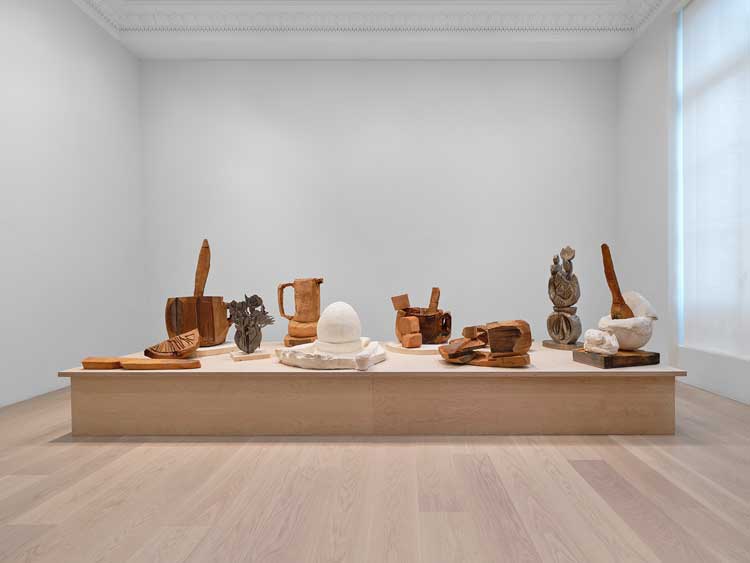
Installation view, Thomas Houseago: Night Sea Journey. Image courtesy of Lévy Gorvy Dayan gallery.
There is a table installed in the gallery that is set with rough, cunningly assembled redwood and plaster saucers, bowls, spoons, a coffeepot, a wonderful cup (reverberant with the twang of Dylan’s song: “One more cup of coffee for the road … ’fore I go/ to the valley below”) accompanied by bread, fruit, eggs, recurrent objects in his repertoire that are related to surrealistic improvisations such as Meret Oppenheim’s fur-lined teacup, say.
I also thought of Ursula von Rydingsvard’s redolent cedar carvings of spoons, shovels and ladles, hers ramped up to heroic status, or perhaps to a childhood sense of scale, which is distorted and simplified in recollection. It might be a mundane breakfast, but it might also be read as ritualistic, as a commemoration and celebration, as a funerary ritual, sending off those who have departed with nourishment and our blessings.

Thomas Houseago. My Coffee, 2024. Plaster, redwood, and pastel, 25½ × 31⅛ × 27¼ in (64.8 × 79.1 × 69.2 cm). Image courtesy of Lévy Gorvy Dayan gallery.
The top floor rocks us with an explosion of dazzling colour that is almost sonic. Entering what can be a blindingly sunny skylighted gallery on a clear day, which contributes exponentially to the illusion that we are now in heaven, or at least in an earthly paradise (like Malibu where these works were made en plein air at the artist’s studio, the sea nearby), we are greeted by another immersive, thickly painted, full-spectrum landscape or skyscape in praise of sublime sunrises and sunsets, of ruddy dawns and dusks, of whitened noons and webs of tangled light. Houseago said that he loved the look of the moon and the sun setting on the ocean. “It catches you in the great rhythms of the cosmos.” But he is also bemused by what he is painting and all the beautiful, bright colours he is using, and finds himself at times reaching involuntarily for blacks, for darker shades.
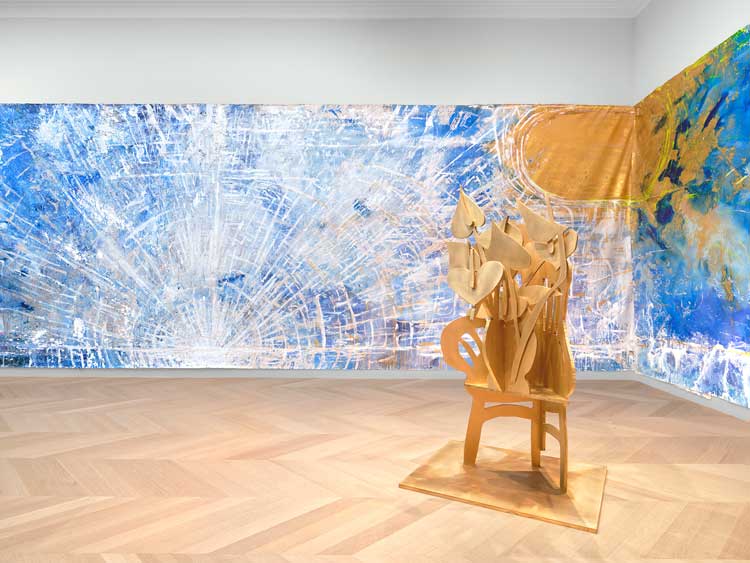
Thomas Houseago. Foreground: My Studio Chair & Flowers, 2024. Brass, 66⅜ × 37⁷⁄₁₆ × 32¹¹⁄₁₆ in (168.6 × 95.1 × 83 cm); Background: Sunrise, 2024. Acrylic and oil on canvas, 120 × 1364 in (304.8 × 3464.6 cm). Image courtesy of Lévy Gorvy Dayan gallery.
In one corner, a chair has been placed, a study of his studio chair made of brass, its seat (metaphorically) flowering. I read it as a reminder that these are art works, that he is an artist, and this is the chair he sits in sometimes, as he is making his work, and it lives, as he does, as we do, in the imagined space that he has created and made real for the moment.
-(1).jpg)
Thomas Houseago, sculptures, Malibu. Photo:Josh White, courtesy of Lévy Gorvy Dayan gallery.